Physical Address
304 North Cardinal St.
Dorchester Center, MA 02124
As understanding of the posterolateral corner (PLC) has increased, its significance to overall knee function and biomechanics has become clearer. Although it is a relatively uncommon injury, PLC injuries can have severe consequences for overall knee stability and function. Missed injuries may affect the outcome of surgeries to correct concomitant injuries. This chapter reviews the epidemiology, relevant anatomy, biomechanics, presentation, examination, imaging, and treatment of PLC injuries. Rehabilitation, potential complications, and future considerations for the management of these serious injuries are also discussed.
Isolated PLC injuries are relatively rare and have been reported to range from 1.6% to 7% of all knee injuries in persons who present for evaluation. However, the true incidence is not fully known, because these injuries are believed to be underreported or often missed at the time of evaluation. In a review of 68 persons with PLC injuries, Pacheco et al. found that 72% were not correctly diagnosed at time of presentation to the hospital and 50% were still misdiagnosed by the time they were referred to a knee specialist. This misdiagnosis may in part be due to the fact that understanding of the PLC has only recently improved. With recent advances, physicians are developing a better understanding of the anatomy, biomechanics, and mechanism of these injuries. In addition, the effects of chronic deficiency on gait, level of activity, natural progression, and impact on the management of other injuries are becoming clearer. Finally, surgical techniques continue to evolve as the best way to treat these injuries continues to be debated.
An understanding of the PLC begins with an understanding of the relevant anatomy of the region. This anatomy is among the most complex around the knee. The PLC has been characterized by dynamic and static restraints, anatomic layers, and various structures with multiple names in the literature, thus making the use of consistent nomenclature difficult.
Seebacher et al. described the structures on the lateral side of the knee in three anatomic layers. The most superficial layer, layer 1, consists of the lateral fascia, iliotibial (IT) band, and the superficial portion of the biceps femoris tendon. The peroneal nerve, located posterior to the biceps, is located in the deepest aspect of layer 1. The intermediate layer, layer 2, consists of the retinaculum of the quadriceps and the proximal and distal patellofemoral ligaments. The deep layer, layer 3, includes the lateral part of the joint capsule, the lateral collateral ligament, the fabellofibular ligament, the coronary ligament, the popliteal tendon, and the arcuate ligament. Even when described in layers, Seebacher et al. found anatomic variations within their dissected specimens.
Recent descriptions have focused more on specific anatomic structures and their relation to the posterolateral knee, including the IT band, lateral collateral ligament, popliteus tendon, long and short heads of the biceps femoris, and several smaller structures ( Fig. 102.1 ).
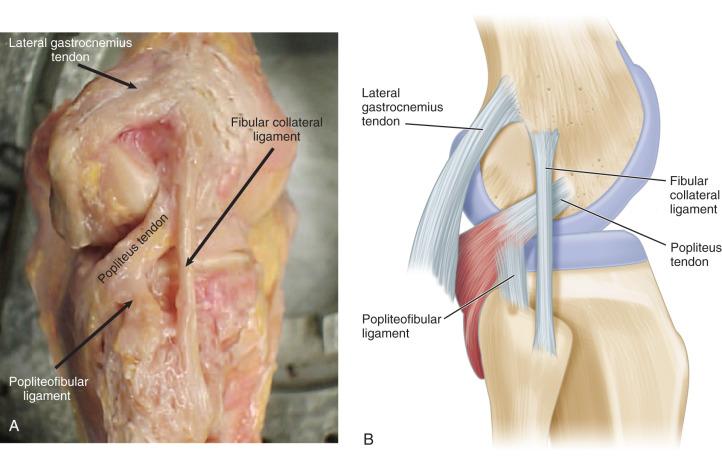
The IT band, or IT tract, is composed of different layers and has at least four separate attachments at the knee. The main component, the superficial layer, which covers much of the lateral side of the knee, has a wide attachment to Gerdy tubercle. In addition, it has an anterior component attaching to the patella called the iliopatellar band, which influences patellar tracking. The deep layer, a structure found on the medial aspect of the superficial layer, attaches to the lateral intermuscular septum of the distal femur. Distal to the lateral epicondyle of the femur, the deep layer blends with the superficial layer and attaches to the Gerdy tubercle. The capsular-osseous layer, beginning at the lateral intermuscular septum of the femur, receives contributions from the lateral gastrocnemius and biceps femoris before inserting on Gerdy tubercle. This layer also has attachments to the patella and can influence patellar tracking. When viewed as a whole, the IT band is the first structure encountered during exposure for PLC reconstruction and serves as a stabilizer of the lateral side of the knee.
With attachments on the fibular head and distal femur, the fibular collateral ligament (FCL; also known as the lateral collateral ligament) is a primary restraint to varus stress on the knee. Its fanlike attachment on the femur is in a bony depression 1.3 to 1.4 mm proximal and 3.1 to 4.6 mm posterior to the lateral epicondyle, but it does not actually attach to the epicondyle. With an average length of 6.3 to 7.1 cm, it traverses distally deep to the superficial layer of the IT band and attaches to the fibular head. The tendon narrows as it courses distally to its narrowest point midway between the femoral and fibular attachments, where it measures 3.4 mm in an anteroposterior (AP) plane and 2.3 mm in a medial to lateral plane. It then expands into its fanlike attachment on the lateral aspect of the fibular head, covering 38% of the width of the head, and is located 8.2 mm posterior and 28.4 mm distal to styloid process. An understanding of FCL anatomy is essential to anatomic surgical reconstruction for both fibular and femoral tunnel placement.
The popliteus begins on the posteromedial aspect of the tibia and courses proximally to insert in the popliteal sulcus on the lateral femoral condyle. At the level of the popliteal fossa, the muscle gives rise to the popliteus tendon, which then inserts into the popliteal sulcus. It is at this musculotendinous junction that the popliteofibular ligament attaches the popliteus to the fibula. The tendon becomes intra-articular and runs medial to the FCL. It then inserts onto the femur typically 9.7 mm distal and 5.3 mm posterior to the lateral epicondyle, which represents a distance of 18.5 mm between the femoral attachments of the two structures, a concept to take into consideration when planning a reconstruction. In addition to its attachments on the femur and tibia, the popliteus contains popliteomeniscal fascicles that extend to the lateral meniscus, as well as attachments to the posterior capsule.
The popliteofibular ligament, originating at the musculotendinous junction of the popliteus, travels distally and laterally to insert on the fibular head. With anterior and posterior divisions, the ligament provides a strong connection between the fibula and the popliteus. The smaller anterior division attaches to the anteromedial aspect of the fibular styloid 2.8 mm from the tip of the styloid, whereas the larger posterior division attaches to the posteromedial aspect of the fibular styloid 1.6 mm distal to the tip of the styloid. The true role of the popliteofibular ligament to overall stability has been debated. Some investigators propose that it is a primary stabilizer to varus stress, external tibial rotation, and posterior tibial translation. However, others have found that it serves purely as a secondary stabilizer, serving a purpose if the FCL is transected.
The long head of the biceps femoris muscle, originating at the ischial tuberosity, travels distally to the knee and forms two tendinous portions, the direct and anterior arms, with the direct arm attaching to the posterolateral fibular head and the anterior arm crossing lateral to the FCL and attaching to the lateral fibular head. The anterior arm is separated from the FCL by the FCL-biceps bursa. This bursa, typically measuring 8.4 by 18 mm, is consistently found between the two structures and serves as a surgical landmark for identifying the FCL attachment to the fibular head. In addition, the long head has three fascial attachments, the reflected arm and the lateral and anterior aponeurosis. The reflected arm travels superficial to the short head of the biceps femoris and inserts on the posterior aspect of the IT tract.
The short head of the biceps femoris, originating from the femur, travels distally at a 45-degree angle to the femur, where it splits into six components, including attachments to the long head of the biceps, the posterolateral aspect of the joint capsule, and the IT tract. The attachment to the capsule (the “capsular arm”) forms a large fascial sheath that includes the fabellofibular ligament. In addition, further distal, the short head attaches just lateral to the tip of the fibular styloid and a separate anterior arm travels proximal to the fibular styloid and medial to the FCL to attach posterior to the Gerdy tubercle. The final component, the lateral aponeurotic expansion, attaches to the posteromedial aspect of the FCL.
The long and short heads of the biceps femoris are innervated by different components of the sciatic nerve. The long head is innervated by the tibial component and the short head by the common peroneal nerve.
The fabellofibular ligament represents the most distal aspect of the capsular arm from the short head of the biceps femoris. Originating from the fabella or fabella-analog, it courses distally to attach to the fibular styloid. It is thought to provide stability to the knee once it has reached close to full extension.
The arcuate ligament complex (also referred to as the arcuate popliteal ligament or arcuate complex ), one of the more inconsistently referenced structures in the knee, is a Y -shaped structure consisting of medial and lateral limbs. Both limbs originate on the fibular styloid process. The lateral limb ascends proximally along the lateral joint capsule to insert on the lateral femoral condyle at the posterior joint capsule, whereas the medial limb courses over the musculotendinous junction of the popliteus, blends with the oblique popliteal ligament (ligament of Winslow), and then inserts variably onto the fabella, if present, or the posterior joint capsule. The arcuate ligament complex, when present, is believed to be more accurately described as a variable confluence of several structures, including the posterior oblique, popliteofibular, fabellofibular, and short lateral ligaments, with the final appearance of a Y -shaped ligament complex. It has been shown to contribute to the prevention of varus instability.
The lateral gastrocnemius tendon originates at the musculotendinous junction of the lateral gastrocnemius muscle and then courses proximally, first attaching to a fabella or fabella-analog before blending into the meniscofemoral portion of posterior capsule. It ultimately attaches to the femur at the region of the supracondylar process 13.8 mm posterior to the fibular collateral attachment and 28.4 mm from the popliteus tendon attachment.
The mid-third lateral capsular ligament, a thickening of the lateral capsule of the knee, originates on the femur in an area around the lateral epicondyle and then travels distally and provides a capsular attachment to the lateral meniscus before inserting on the tibia between the Gerdy tubercle and the popliteal hiatus. It is composed of meniscotibial and meniscofemoral ligaments. Clinically, the meniscotibial ligament is responsible for the Segond fracture, an avulsion of the lateral tibial plateau. A Segond fracture can easily be seen on radiographs and magnetic resonance imaging (MRI) and is indicative of ligamentous injury to the knee.
The peroneal nerve is intimately related to the structures of the PLC. As a result, the nerve is injured in 13% of PLC injuries. In the popliteal fossa, the sciatic nerve splits to form the tibial and common peroneal nerves. The peroneal nerve courses distal and lateral to emerge from under the biceps femoris and then passes behind the fibular neck, ultimately passing deep to the peroneal longus. The nerve is located approximately 15 mm from the joint capsule.
The inferior lateral genicular artery is the main artery associated with the PLC. Originating from the popliteal artery, it is found along the posterior joint capsule proximal to the lateral meniscus. It continues laterally and passes anterior to the fabellofibular ligament and posterior to the popliteofibular ligament before traveling within the lateral capsular ligament along the lateral meniscus.
With its complex anatomy and its association with the function of other ligaments, the biomechanics of the PLC have proven difficult to determine and remain difficult to understand. In its most basic terms, the PLC serves to resist varus angulation, external tibial rotation, and posterior tibial translation. Through cadaveric sectioning studies, the role of individual structures has become clearer. Previous studies have identified the lateral collateral ligament, popliteus tendon, and popliteofibular ligament as being the key structures contributing to PLC function and stability. In addition, the PLC structures affect the function and loads seen on the cruciate ligaments ( Fig. 102.2 ).
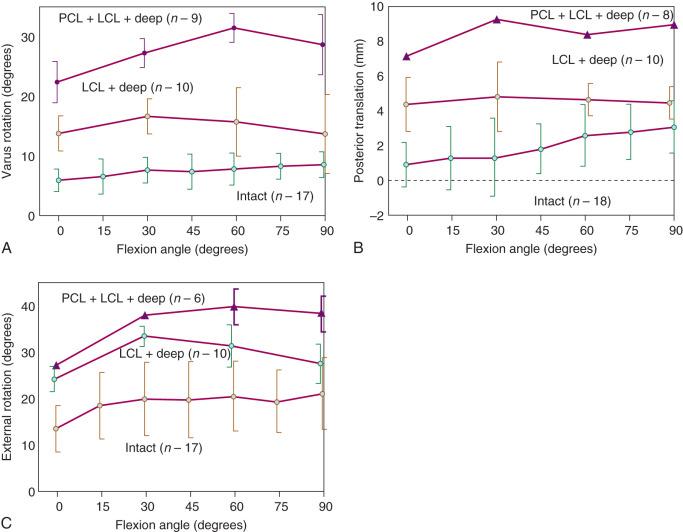
The FCL is the primary restraint to varus stress. Sectioning of the FCL causes increases in varus motion in all degrees of knee flexion. As long as the FCL remains intact, minimal change occurs in varus translation regardless of what other structures may be torn. However, isolated sectioning of the popliteus tendon has shown small but significant increases in varus motion, but to a much smaller degree than isolated sectioning of the FCL. Varus stress produces the greatest load on the FCL with the knee in 30 degrees of flexion, and the load subsequently decreases once the knee reaches 90 degrees of flexion, with an ultimate maximum tensile load of 295 to 309 N. Once the FCL is torn, secondary structures assume the main restraint to varus motion, including the posterior cruciate ligament (PCL), popliteofibular ligament, posterior capsule, mid-third lateral capsule ligament, IT band, and popliteal tendon. This primary function of the FCL is essential to consider during reconstruction to recreate the main contributor to varus stability in the knee.
The popliteus tendon and the popliteofibular ligament are the primary restraints to external rotation. Isolated sectioning of the popliteus leads to significant increases in external rotation, and conversely, a reconstructed popliteus demonstrates significantly decreased external rotation compared with a sectioned specimen. However, the FCL appears to have a greater contribution to external rotation stability than previously thought, especially at 30 degrees of knee flexion where the maximal load from external rotation forces is greater on the FCL than on the popliteus and popliteofibular ligament. Consequently, it appears that the FCL plays a primary role in external rotation restraint when the knee is closer to full extension, and the popliteus and popliteofibular ligament assume responsibility with increasing degrees of knee flexion.
The PCL also affects external rotation resistance. The PLC and PCL work in concert to resist external rotation stresses. Isolated sectioning of the PCL does not affect external rotation motion of the knee if the PLC is intact. As noted, the PLC experiences greatest external rotation moments at 30 degrees of knee flexion. The PCL does not experience external rotation loads until 80 to 90 degrees of knee flexion, when it becomes a secondary stabilizer to external rotation, thus explaining why in the dial test, decreased external rotation at 90 degrees compared with 30 degrees of knee flexion suggests an intact PCL and an isolated PLC injury.
Injured PLC structures have little effect on total anterior tibial translation if the anterior cruciate ligament (ACL) is intact. The FCL, popliteus, and popliteofibular ligament each experience negligible force when subjected to an anterior drawer test in a knee with a competent ACL. This finding is significant during the physical examination. In persons with an isolated PLC injury, findings of the Lachman test and anterior drawer test will be mostly normal because of the minimal impact of the PLC on anterior tibial translation. Slight differences in total translation may be found because sectioning the popliteus can cause up to a 2.6-mm increase of anterior translation. However, the test should have a firm end point and very minimal clinical difference, although if the ACL is also torn, the combined ACL/PLC injury leads to significantly increased anterior tibial translation. Combined sectioning of the PLC and ACL causes an additional 7 mm of anterior translation, which may lead to a more pronounced Lachman test during the physical examination.
Isolated PLC injuries can cause increased posterior tibial translation, even in the setting of an intact PCL. This increase is small but significant, with the greatest increase occurring in the first 45 degrees of knee flexion. In the knee with a deficient PCL, the PLC assumes a major stabilizing role, with increases in force load of six to eight times that of the knee with an intact PCL, especially at higher degrees of knee flexion. Total posterior tibial translation increases significantly, up to 20 to 25 mm, when both the PCL and PLC are torn and no longer resist posterior tibial translation. Clinically, this finding is manifested in a more pronounced posterior drawer test than is found with isolated PCL tears, with a minimum of at least a grade 3 posterior drawer in the combined injury setting.
Recent biomechanical studies have focused on the reconstruction of the cruciate ligaments in the setting of concomitant PLC injury to better explain the higher failure rate seen after cruciate ligament reconstruction in the knee with multiple ligament injuries. Graft rupture after ACL reconstruction has been reported to range from 1.8% to 10.4%, with an average rate of 5.8% reported in a recent review. It is becoming increasingly clear that missed PLC injuries may contribute to a higher failure rate. In response to varus load, ACL graft forces are increased with isolated FCL sectioning, and this force is further increased with varus and external rotation loads. In addition, concomitant reconstruction of the ACL and PLC decreases instability by allowing less anterior tibial translation, and instability was the major reason cited for poor subjective outcomes by patients with residual PLC injury after ACL reconstruction.
In the setting of PCL injury, concomitant injury to the PLC is the most frequently associated injury and occurs in up to 60% of all PCL injuries. A missed PLC injury can affect the success of PCL reconstruction. In an isolated PCL injury, forces on the PCL graft resulting from external rotation loads, posterior tibial loads, or combined posterior and external rotation loads are similar to the native PCL. However, in the setting of residual PLC injury, forces acting on the PCL graft are increased during all loading conditions, with increases as much 150% on the reconstructed graft. The increased load may predispose the PCL reconstruction to failure.
Classification systems have been created on the basis of the amount of instability and the location of the injury ( Table 102.1 ). The American Medical Association initially standardized ligamentous injuries into grades I, II, and III based on the extent of injury and subsequent motion. Hughston et al. were the first to classify lateral side instability and identified six types of lateral compartment instability based on physical examination tests: anterolateral rotatory instability, posterolateral rotatory instability, combined anterolateral and posterolateral rotatory instability, combined anterolateral and anteromedial rotatory instability, combined posterolateral, anterolateral, and anteromedial rotatory instability, and straight lateral instability. These types were graded on the basis of various clinical exams as 1+, or minor, if the joint surfaces separated 5 mm or less; 2+, or moderate, if they separated 5 to 10 mm; and 3+, or severe, if they separated 10 mm or more. A classification system was developed by Fanelli and Feldmann based on the location of the injury. Finally, injuries can be classified more simply as either stable or unstable, because it is instability that dictates surgical management.
| System/Grade | Description |
|---|---|
| AMA | Injury Severity |
| I | Minimal tearing of ligament fibers, no increased motion |
| II | Partial tear of ligament, slight to moderate abnormal motion |
| III | Complete tear of ligament, loss of function and marked abnormal motion |
| Fanelli | Structures Injured |
| A | Popliteofibular ligament and popliteus tendon |
| B | Popliteofibular ligament, popliteus, and fibular collateral ligament |
| C | Popliteofibular ligament, popliteus, fibular collateral ligament, lateral capsule avulsion, and cruciate ligament disruption |
| Hughston | Amount of Instability |
| 1+ | Opening of 0–5 mm to varus stress |
| 2+ | Opening of 5–10 mm to varus stress |
| 3+ | Opening of 10+ mm to varus stress |
Most PLC injuries are sustained during athletic competitions, motor vehicle accidents, and falls. In one study, 65% of injuries were sports related, with 26% from motor vehicle accidents and 9% from falls. A typical mechanism is a posterolaterally directed force to the anteromedial tibia, which leads to hyperextension and a varus force. Additional mechanisms include knee hyperextension or severe tibial external rotation in a partially flexed knee, and both contact and noncontact mechanisms have been reported. An emerging mechanism that is increasing in frequency is injury during low-energy knee dislocation in obese persons. Azar et al. reported on 17 obese persons with “ultra–low-velocity” knee dislocations, of which 50% had documented injury to the lateral-sided structures. In the United States alone, 35.7% of adults are considered obese, which is not only a major risk factor identified for these ultra–low-velocity knee dislocations but also increases the risk of limb-threatening neurovascular injury during dislocation.
PLC injuries are rarely isolated and are associated with concomitant injuries in 43% to 87% of patients. These associated injuries commonly include ACL and PCL tears, as well as tibial plateau fractures. In the study by Gardner et al. of operative tibial plateau fractures, 29% of the fractures had a complete FCL tear and 68% had injuries to the popliteofibular ligament and/or the popliteus tendon. Given that PLC injuries can occur in the setting of knee dislocations, in the case of multiple ligamentous injury, high clinical suspicion should be maintained for spontaneously reduced knee dislocation and subsequent neurovascular injury.
In the acute setting, patients present after some form of trauma and report pain, typically at the posterolateral aspect of the knee and at the fibular head. They will have varying degrees of effusion. In a prospective study, LaPrade et al. reported that 9.1% of patients presenting with a knee hemarthrosis had a PLC injury. Initially, depending on the degree of trauma, the basics of trauma care should be followed. First, a thorough primary survey consisting of airway, breathing, and circulation should be performed. During the secondary survey, a more detailed musculoskeletal examination can be completed. Gross deformity may suggest a knee dislocation. Recognizing a vascular injury is of paramount importance, and failure to do so can lead to amputation. In an acute setting, a detailed neurovascular examination should be performed. An ankle-brachial index score should be obtained, and any abnormal finding warrants additional workup and consultation. A thorough neurologic examination is necessary because of the high incidence of peroneal nerve injuries associated with PLC tears. Particular attention should be given to peroneal nerve sensation, as well as ankle dorsiflexion, eversion, and great toe extension.
In the chronic setting, patients often report pain at the medial joint line and/or lateral joint line, as well as at the posterolateral aspect of the knee. However, with time, swelling and pain subside and instability becomes a primary complaint. This instability is most evident with the knee in extension and often presents as a varus or hyperextension-varus thrust during the stance phase of gait. Patients experience difficulty ascending and descending stairs, may be seen walking with the knee in slight flexion or the ankle in equinus to alleviate these symptoms, and report having difficulty with twisting, pivoting, and cutting exercises. One must also be mindful of the potential for a steppage gait if a foot-drop occurs from a concomitant peroneal nerve injury.
For both chronic and acute cases, the physical examination should begin with an evaluation of the entire extremity, looking for areas of tenderness, ecchymosis, and deformity. As stated earlier, a detailed neurovascular examination is essential to evaluate for neurovascular injury. Overall limb alignment should be evaluated because it is important to identify varus malalignment. This malalignment may not only exacerbate the instability but may also predispose a reconstruction to increased risk of failure.
Next, examinations specific for ligamentous injury of the knee should be performed, which includes assessing for ACL, PCL, and medial collateral ligament (MCL) injuries. A thorough evaluation of the PLC is then pursued. In the series by DeLee et al., all patients had tenderness and swelling diffusely over the posterolateral joint. Point tenderness is often found at the fibular head. Varus stress examination is paramount to a basic physical examination. This test should be performed with the knee in both full extension, as well as at 30 degrees of flexion. Varus instability in full extension is suggestive of a PLC injury and a PCL injury, whereas isolated instability at 30 degrees of flexion is more suggestive of an isolated PLC injury. One must be sure that when testing at 30 degrees of flexion, a pure varus directed force is applied without external rotation of the tibia, which could contribute to false-positive examinations. In a the series of PLC injuries to the knee reported by DeLee et al., the most sensitive examination technique was varus instability with the knee at 30 degrees of flexion. The frog-leg maneuver is a newly described clinical test for identifying posterolateral knee instability. With the patient lying supine, both knees are abducted and flexed to 90 degrees, bringing the soles of the feet together (frog-leg position). A varus stress is applied, and the index or middle fingers of each hand are used to palpate the lateral joint lines to assess for lateral compartment gapping. When combined with the frog-leg test, the sensitivity of the conventional varus stress test has been found to increase from 83.3% to 90.0%.
Other more specific tests for a PLC injury exist, including the posterolateral drawer test, the external rotation recurvatum test, the dial test, the standing apprehension test, and the reverse pivot shift.
The posterolateral drawer test has been described by having the physician flex the hip to 45 degrees and the knee to 80 degrees. The tibia is held in mild external rotation (approximately 15 degrees). With the examiner's thumbs on the tibial tubercle ( Fig. 102.3 ), a posterior directed force on the proximal tibia will cause the tibial plateau to rotate posterolaterally on the femur. The examiner should feel the posterolateral rotation.
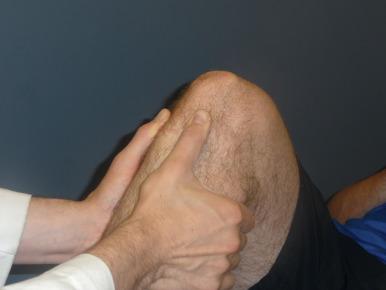
The dial test is performed by positioning the patient either prone or supine with the knee at the edge of the examination table. If the patient is supine, an assistant must stabilize the knees to hold the patella in line. The knees are flexed to 30 degrees, and both feet are externally rotated. The same maneuvers are then performed at 90 degrees of knee flexion. A difference in external rotation of 10 to 15 degrees or more compared with the contralateral side is a positive test. Increased external rotation at 30 degrees of flexion indicates an isolated PLC injury ( Fig. 102.4 ). A positive examination finding at both 30 degrees and 90 degrees of flexion raises suspicion for a PCL injury in addition to the PLC injury. Tibial positioning during testing is important because reduced tibial external rotation will be found on the dial test with a posteriorly subluxated tibia. Therefore when performing the dial test, an anterior force should be applied to the tibia if a concomitant PCL injury is suspected. This full reduction of the tibia will allow for a more accurate estimate of tibial external rotation with dial testing.
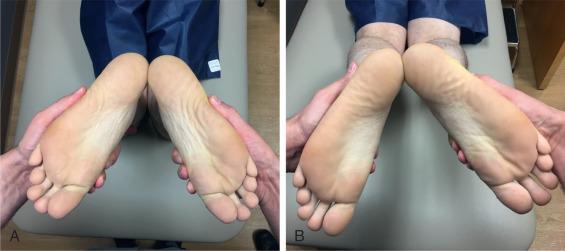
The external rotation recurvatum test, described by Hughston and Norwood, is performed by lifting the great toe of a patient in the supine position to observe the quantity of genu recurvatum ( Fig. 102.5 ). The amount of recurvatum can be measured with a goniometer or the distance from the heel to the examination table. One should also note differences in varus alignment and tibial external rotation. The external rotation recurvatum test is less sensitive for PLC injuries because it has been proposed that the intact anteromedial bundle of the ACL provides some stability with this maneuver. For this reason, this test can be useful in identifying PLC injury with an ACL tear. For identifying combined ACL/PLC injuries, this test has sensitivity of 100% but specificity of 30%. One must be aware that this test has a high rate of false-negative findings in the setting of PLC injuries with intact ACLs. It is seldom useful for isolated PLC injuries or combined PLC/PCL injuries. Finally, an important consideration is that the posterolateral drawer test demonstrates instability in flexion, whereas the external rotation recurvatum test demonstrates instability in extension.
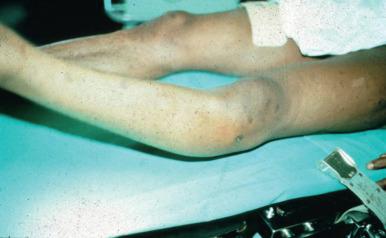
The standing apprehension test ( Fig. 102.6 ) is performed by having the patient stand with the knee at almost full extension. A force is the directed medially across the anterolateral femur. To consider this test positive, the patient must feel an unstable sensation and rotation of the femur on the tibia must occur. The utility of this examination should be placed in context with the remainder of the history and examination because it has the potential to be nonspecific.
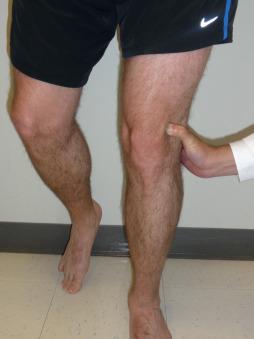
The reverse pivot shift is another specific test for the PLC that is specific for the FCL, mid-third lateral capsular ligament, and popliteus complex. To perform this maneuver, the knee is flexed to 45 degrees with a valgus stress transmitted through the externally rotated foot. With subsequent extension of the leg, a subluxation is felt at approximately 25 degrees of flexion. Biomechanically, the posteriorly subluxated lateral tibial plateau reduces at 20 to 30 degrees of flexion because the IT band changes from knee flexor to extensor. False-positive rates have been reported to be as high as 35%, and thus careful comparison with the unaffected limb is essential.
Gait examination is more useful in the chronic injury setting. During ambulation, the patient may have the appearance of a varus thrust with a lateral tibial shift. These findings can be attributed to external rotation of the tibia during full extension in the stance phase of the gait cycle. Previous authors liken this gait examination to a standing external rotation recurvatum test. Furthermore, a hyperextension thrust gait can be present when loading the lower extremity during the early stance phase. For this reason, some patients walk with a flexed knee.
The physical examination is critical in the detection of PLC injuries. Although modern imaging modalities are highly accurate for detecting injury to these structures, it is believed that they may be oversensitive for these injuries. In addition, imaging cannot replace the physical examination for assessing clinical instability resulting from injury. Therefore the physical examination is the most important part of the workup to determine the need for operative intervention of PLC injuries. In essence, the examiner should trust the physical examination during the decision-making process.
Become a Clinical Tree membership for Full access and enjoy Unlimited articles
If you are a member. Log in here